Research News
-
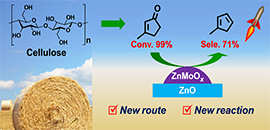 01 07, 2021Researchers Synthesize Bio-based Methylcyclopentadiene with 3-Methylcyclopent-2-enoneScientists synthesized bio-based MCPD via direct hydrodeoxygenation of 3-methylcyclopent-2-enone (MCP) derived from cellulose.
01 07, 2021Researchers Synthesize Bio-based Methylcyclopentadiene with 3-Methylcyclopent-2-enoneScientists synthesized bio-based MCPD via direct hydrodeoxygenation of 3-methylcyclopent-2-enone (MCP) derived from cellulose.
Methylcyclopentadiene (MCPD) is an important monomer in the production of RJ-4 fuel, a high-energy-density rocket fuel, and it is also widely used in the synthesis of various valuable products.
Currently, MCPD is mainly obtained from the by-products of petroleum cracking tar at a very low yield of ~ 0.7 kg ton-1 and high price of ~10,000 USD ton-1. The exploration of highly efficient processes to convert renewable biomass to MCPD is stimulated by the energy and environment problems.
Recently, a group led by Prof. LI Ning and Prof. ZHANG Tao from the Dalian Institute of Chemical Physics (DICP) of the Chinese Academy of Sciences (CAS) synthesized bio-based MCPD via direct hydrodeoxygenation of 3-methylcyclopent-2-enone (MCP) derived from cellulose.
Their study was published in Nature Communications on Jan. 4.
Direct hydrodeoxygenation of MCP to MCPD on the partially reduced Zn-Mo oxide catalyst (Image by WANG Ran and LIU Yanting)
The researchers found that selective hydrodeoxygenation of MCP to MCPD could be achieved on the partially reduced Zn-Mo oxide catalyst.
The Zn-Mo oxide catalyst formed ZnMoO3 species during the reduction of ZnMoO4, which might preferentially adsorb C=O bond in the presence of C=C bond in vapor phase hydrodeoxygenation of MCP, leading to highly selective formations of MCPD with a carbon yield of 70%.
"This is a following work of our previous report about the synthesis of 2,5-hexanedione by the direct hydrogenolysis of cellulose and the intramolecular aldol condensation of 2,5-hexanedione to MCP," said Prof. LI.
This study opens up a horizon for the production of dienes with unsaturated ketone by a direct hydrodeoxygenation process.
This work was supported by the National Natural Science Foundation of China, Innovation Research Fund Project of DICP, and the DNL Cooperation Fund, CAS. (Text by WANG Ran and LIU Yanting) -
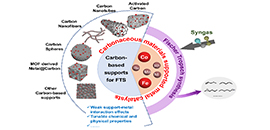 01 06, 2021Carbon-based Catalysts Used for Fischer-Tropsch Synthesis
01 06, 2021Carbon-based Catalysts Used for Fischer-Tropsch Synthesis
Fischer-Tropsch synthesis (FTS) is an essential approach to convert coal, biomass, and shale gas into fuels and chemicals, such as lower olefins, gasoline, and diesel.
Traditional supports materials, such as Al2O3, SiO2, TiO2 have strong interactions with metal particles, affecting their catalytic activity. The inert surface of carbon-based materials can weaken the strong metal-support interaction and improve the reducibility of active metals, thereby enhancing the catalytic activity.
Recently, a research team led by Prof. LIU Jian from the Dalian Institute of Chemical Physics (DICP) of the Chinese Academy of Sciences, in cooperation with Prof. Andrei Y. Khodakov from Unité de Catalyse et Chimie du Solide of Centre National de la Recherche Scientifique (UCCS, CNRS), reviewed the application of carbon-based catalysts for FTS.
The researchers summarised the substantial progress in the preparation of carbon-based catalysts for FTS by applying activated carbon (AC), carbon nanotubes (CNTs), carbon nanofibers (CNFs), carbon spheres (CSs), and metal-organic frameworks (MOFs) derived carbonaceous materials as supports.
Carbonaceous materials supported metal catalysts for FTS(Image by CHEN Yanping and WEI Jiatong)
"We want to provide critical and comprehensive progress regarding carbon-based catalysts for FTS for researchers to quickly obtain an overview of this area," said Prof. LIU.
They also discussed the current development about the application of carbon-based Co, Fe, and other metals (Mo, Ni, Rh, Ru) catalysts for FTS in detail, in terms of their special characteristics, as well as the comparison of catalytic performances of various carbon-based catalysts.
Carbon-based materials could serve as inert supports to adjust the interaction between the active phase and supports.
This study was published on Chemical Society Review on Jan. 4.
It was supported Liaoning Natural Science Foundation, LiaoNing Revitalization Talents Program, Dalian National Laboratory for Clean Energy (DNL), and DNL Cooperation Fund. (Text by CHEN Yanping) -
 01 05, 2021Scientists Identify Transition Metal for Highly-efficient CO2 ActivationScientists characterized a transition metal M[η2-(O,O)C] species for highly-efficient CO2 activation.
01 05, 2021Scientists Identify Transition Metal for Highly-efficient CO2 ActivationScientists characterized a transition metal M[η2-(O,O)C] species for highly-efficient CO2 activation.
The atmospheric concentration of carbon dioxide (CO2) has been increasing over the past century, imposing severe consequences for global climate change and planetary temperature increase.
To reduce CO2 from the atmosphere and take it as the feedstock for sustainable energy sources, the capture and utilization of CO2 to create valuable chemicals is highly desired.
A research team led by Prof. JIANG Ling and Prof. FAN Hongjun from the Dalian Institute of Chemical Physics (DICP) of the Chinese Academy of Sciences, in collaboration with Prof. ZHAO Zhi from Hebei University of Engineering, characterized a transition metal M[η2-(O,O)C] species for highly-efficient CO2 activation.
The result was published in The Journal of Physical Chemistry Letters on Dec. 28.
Spectroscopic Identification of Transition-Metal M[η2-(O,O)C] Species for Highly-Efficient CO2 Activation (Image by ZHENG Huijun)
Based on the recently-developed infrared photodissociation spectroscopy apparatus, the researchers synthesized and characterized an unprecedented transition metal M[η2-(O,O)C] motif with bidentate double oxygen metal-CO2 coordination in the [ZrO(CO2)n>=4]+ complexes.
The Zr[η2-(O,O)C] species yielded a CO2- radical ligand, showing high efficiency in CO2 activation. The CO2- radical and non-linear character of these series of M[η2-(O,O)C] complexes might enable high reactivity in many important reactions such as C-C coupling and C-H activation.
There were two important prerequisites for certain metals to form this intriguing M[η2-(O,O)C] species: the metal center had high reduction capability and the oxidation state of the metal center was lower than its highest one by one.
Systematic analyses for the effects of different transition and main-group metals on the formation of M[η2-(O,O)C] complexes provided comprehensive insights into the microscopic mechanism of CO2 activation by a single metal center, offering design criteria for single-atom catalyst with isolated transition metal atoms dispersed on supports. Such advances might be integrated into the CO2-activation and -utilization technology.
This study highlights the pivotal roles played by the M[η2-(O,O)C] species in CO2 activation and also opens new avenues towards the development of related single-atom catalysts with isolated transition metal atoms dispersed on supports. (Text by ZHENG Huijun) -
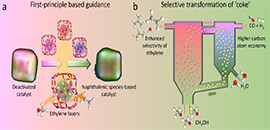 01 05, 2021Researchers Regenerate Deactivated Catalyst in Methanol-to-olefins ProcessScientists regenerated deactivated catalyst in industrially important methanol-to-olefins (MTO) process by directly transforming the coke deposited on the zeolite catalyst to active intermediates rather than burning off to carbon oxide.
01 05, 2021Researchers Regenerate Deactivated Catalyst in Methanol-to-olefins ProcessScientists regenerated deactivated catalyst in industrially important methanol-to-olefins (MTO) process by directly transforming the coke deposited on the zeolite catalyst to active intermediates rather than burning off to carbon oxide.
Methanol-to-olefins (MTO) process is a catalytic process converting methanol to olefins over SAPO-34 zeolite catalyst. It’s becoming one of the main streams for producing light olefins, including ethylene and propylene, from non-oil resources.
One of the major challenges in MTO is the rapid deactivation of zeolite catalyst due to the coke deposition.
In industrial practices, a fluidized bed reactor-regenerator configuration is normally used in order to maintain the continuous operation, in which the air or oxygen is usually input to burn off the deposited coke to restore the catalyst activity in the regenerator. This involves the transformation of coke species to CO2, with a substantial fraction of carbon resource being converted to low-value greenhouse gas.
A research group led by Prof. YE Mao and Prof. LIU Zhongmin from the Dalian Institute of Chemical Physics (DICP) of the Chinese Academy of Sciences regenerated deactivated catalyst in MTO process by directly transforming the coke deposited on the zeolite catalyst to active intermediates rather than burning off to carbon oxide.
This result was published in Nature Communications on Jan. 4.
Schematic illustrations of selective transformation of coke into specific intermediates (Image by GAO Mingbin)
MTO follows the hydrocarbon pool mechanism, i.e. the light olefins are favorably formed with the participation of active intermediate species, or called hydrocarbon pool species (HCPs), during the reaction. The HCPs will evolve into coke species that deactivate catalyst.
By using the density functional theory (DFT) calculations and multiple spectroscopy techniques, this team showed that naphthalenic cations, amongst HCPs, were highly stable within SAPO-34 zeolites at high temperature, and steam cracking could directionally transform the coke species in SAPO-34 zeolites to naphthalenic species at high temperature.
This results not only recovered the catalyst activity but also promoted the formation of light olefins owing to the synergic effect imposed by naphthalenic species.
Furthermore, the researchers verified this technology in the fluidized bed reactor-regenerator pilot plant in DICP with industrial-alike continuous operations. They achieved an unexpectedly high light olefins selectivity of 85% in MTO reaction and 88% valuable CO and H2 with negligible CO2 in regeneration.
This technology opens a new venue to control the selectivity of products via regeneration in industrial catalytic processes.
This study was supported by the National Natural Science Foundation of China and Innovation program of science and research from DICP. (Text by GAO Mingbin) -
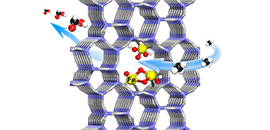 01 04, 2021Researchers Convert Methane to Formic Acid at High Efficiency under Mild ConditionsResearcher from DICP reported highly-dispersed coordinatively unsaturated Fe-sites confined within the ZSM-5 channels enabled highly efficient methane conversion to formic acid (HCOOH) under mild conditions.
01 04, 2021Researchers Convert Methane to Formic Acid at High Efficiency under Mild ConditionsResearcher from DICP reported highly-dispersed coordinatively unsaturated Fe-sites confined within the ZSM-5 channels enabled highly efficient methane conversion to formic acid (HCOOH) under mild conditions.
Methane is promising energy resource for producing high-value-added chemicals. Methane conversion to value-added chemicals or fuels under mild conditions has become one of the hottest topics in energy and catalysis.
However, the high symmetry and low polarizability of methane molecule make it challenging to activate methane under mild conditions. In addition, the target products are usually more reactive than the methane, and they are subject to over-oxidation to the greenhouse gas CO2.
Recently, a group led by Prof. DENG Dehui and Assoc. Prof. YU Liang from the Dalian Institute of Chemical Physics (DICP) of the Chinese Academy of Sciences (CAS) converted methane to formic acid (HCOOH) at high efficiency under mild conditions.
Their study was published in Nano Energy on Dec. 29.
Methane conversion to formic acid on the atomically-dispersed Fe sites confined within the channels of ZSM-5 (Image by ZHU Kaixin and GAO Hehua)
The researchers found that highly efficient and selective oxidation of methane to HCOOH could be achieved on the atomically-dispersed Fe sites confined within the channels of ZSM-5.
By adjusting the silica-alumina ratio and Fe loading in the ZSM-5 to modulate the microenvironment of the active Fe species, they reached a turnover frequency (TOF) of 84200 h-1 for producing C1 oxygenates and a high HCOOH selectivity of 91% with productivity of 383.2 mmol gcat.-1 h-1 at 80 °C
"This result surpassed all previously reported methane conversion catalysts operated under similar conditions," said Prof. DENG.
Furthermore, by combining various characterizations and density functional theory calculations, they found that Fe-O active sites could be generated from H2O2 dissociation on both the mononuclear and binuclear Fe centers confined within the channels of ZSM-5.
The Fe-O active sites could facilitate the activation and cleavage of the C-H bond of methane and thereby promoted successive oxidation of methane to formic acid through methanol and formaldehyde via free radical pathways, while inhibiting the over-oxidation to CO2.
This study paves a new route to design and construct lattice-confined active sites for highly efficient conversion of methane under mild conditions.
This work was supported by the National Key R&D Program of China, the National Natural Science Foundation of China, the Strategic Priority Research Program of CAS, and the DNL Cooperation Fund, CAS. (Text by ZHU Kaixin and GAO Hehua) -
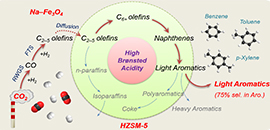 12 30, 2020Researchers Synthesize Light Aromatics from CO2 Hydrogenation
12 30, 2020Researchers Synthesize Light Aromatics from CO2 Hydrogenation
Aromatics are usually produced from petroleum via chemical conversion processes, which are energy intensive and accompanied by high CO2 emissions.
Using CO2 as a feedstock for the sustainable production of aromatics through catalytic hydrogenation is an economically and environmentally viable approach to address the pressing challenges of energy demand and global warming.
A research team led by Assoc. Prof. SUN Jian, Prof. GE Qingjie and Assoc. Prof. WEI Jian from the Dalian Institute of Chemical Physics (DICP) of the Chinese Academy of Sciences synthesized light aromatics from CO2 hydrogenation by precisely regulating Bronsted acid sites (BAS).
This study was published in Applied Catalysis B: Environmental on October 17.
Precisely regulating Bronsted acid sites to promote the synthesis of light aromatics via CO2 hydrogenation (Image by WEI Jian and YAO Ruwei)
The scientists studied a series of composite catalysts comprising Fe-based component and ZSM-5 zeolites with distinct Bronsted acidities to explore the influence of BAS on the light aromatic synthesis and coke formation in CO2 hydrogenation.
They found that BAS of ZSM-5 were the main active sites for aromatization, and the increasing of Bronsted acidity significantly promoted the synthesis of aromatics, especially light aromatics. The further passivation of the external BAS of HZ(25) zeolite by silylation process could inhibit the alkylation of light aromatics and the isomerization of xylene.
The results showed that light aromatics accounted for up to 75% of aromatics, which was the highest value reported in CO2 hydrogenation, and p-xylene could make up as high as 72% of xylene. Moreover, a larger density of BAS, which promoted the formation of highly condensed, carbon-rich, and hard-to-oxidize coke, would accelerate the coke formation, degrade their physico-chemical properties, and shorten the catalyst lifetime.
This work provides a promising strategy to directly synthesize high-valued light aromatics from CO2 and H2, which is importance to cope with energy and environmental problems.
This work was supported by the National Natural Science Foundation of China and the Strategic Priority Research Program of the Chinese Academy of Sciences. (Text and Image by WEI Jian and YAO Ruwei)